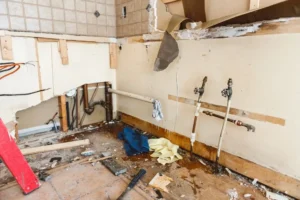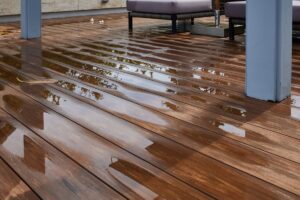Freezing temperatures in Georgetown, Texas, may be rare, but when they occur, they can wreak havoc on plumbing systems. Cracked pipes are a common result of freezing weather, causing water to flood your property and leading to costly repairs if not addressed quickly.
Acting fast is essential to minimize water damage, prevent mold growth, and restore your plumbing system. In this post, we’ll provide step-by-step guidance on what to do if your pipes crack during a freeze and explain how RestoTek can help with expert repairs and water damage restoration services.
What You Should Do When Pipes Crack During a Freeze
#1 – Shut Off the Main Water Supply
The first step when a pipe cracks is to stop the water flow by turning off the main water valve. This valve is typically located near the water meter, often in a basement, utility room, or outside your home. Shutting off the water immediately prevents further flooding and reduces the risk of additional damage. Once the water is off, open nearby faucets to relieve pressure in the system and prevent more cracks.
#2 – Cut Electricity in Affected Areas
If water from the cracked pipe has reached electrical outlets, appliances, or wiring, turn off the power in those areas immediately. Locate your home’s circuit breaker and shut off the electricity to the impacted rooms. This step is critical for preventing electrical shocks or fires caused by water contact with live wiring. If you’re unsure whether it’s safe to access the breaker, wait for professional assistance to avoid potential hazards.
#3 – Drain the Remaining Water
After shutting off the main valve, you’ll need to drain the water remaining in your pipes. Start by opening all cold-water faucets in your home, beginning with the lowest level and working your way up. Flush toilets to release water from the tanks, and if the cracked pipe is part of your hot water system, turn off the water heater and open the hot water taps. Draining the system reduces the risk of further leaks and helps prepare the plumbing for repairs.
Critical Next Steps
#4 – Remove Standing Water
Once the water flow is under control, focus on removing any standing water to prevent further damage to floors, walls, and belongings. Use towels, mops, or a wet/dry vacuum to soak up water as quickly as possible. Standing water can seep into building materials, weakening structures and fostering mold growth. For large-scale flooding, professional water removal services may be necessary to ensure all water is thoroughly extracted from hidden areas.
#5 – Dry Area & Structure
Drying out the affected areas is crucial to prevent mold and long-term damage. Set up fans and dehumidifiers to dry carpets, walls, and furniture thoroughly. Move wet furniture and belongings to a dry area to prevent additional damage. If moisture has seeped into hard-to-reach spaces, such as inside walls or under flooring, professional drying equipment may be required. RestoTek provides advanced drying solutions to ensure that no moisture is left behind, protecting your property from mold and structural issues.
Why Cracked Pipes Need Professional Help
Cracked pipes need more than a temporary fix—they require professional attention to ensure the problem doesn’t recur. A licensed plumber can replace damaged sections of pipe with durable materials that can withstand future cold snaps.
Attempting DIY repairs often leads to incomplete solutions, increasing the likelihood of leaks or bursts in the future. Professional repairs ensure the job is done right the first time, protecting your plumbing system and your property.
Protect Your Georgetown Property with RestoTek
Don’t let cracked pipes during a freeze cause lasting damage to your property. Contact RestoTek for expert pipe repairs, water damage restoration, and preventative plumbing services in the Georgetown area. Reach out and schedule your consultation today, and let us help you protect your home or business from the challenges of freezing weather.



